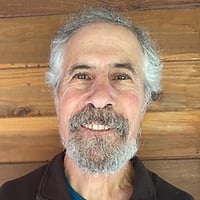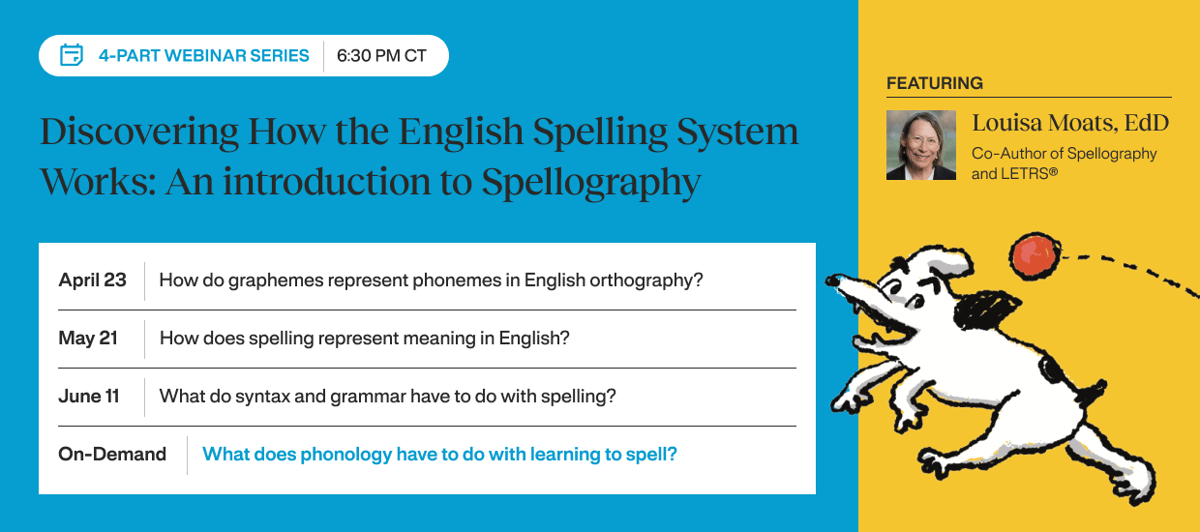Discovering How the English Spelling System Works: An introduction to Spellography
The English spelling system is complex and confusing, especially for students who experience literacy struggles. As students get older, minor issues can become learning challenges, hindering spelling and literacy success.
In this four-part webinar series, taught by Dr. Louisa Moats, co-author of Spellography, we will break down the layers of language and help educators see how the various parts work interchangeably together and build upon each other. Spellography is a classroom-tested program that explicitly teaches spelling concepts to help students make sense of the English spelling system and become better at understanding, reading, and writing words.
Each self-contained webinar:
- provides insight and information for immediate application
- builds upon the other to better understand the critical aspects of spelling
- empowers teachers with the knowledge to help students become better spellers
Complete the form to register for this 4-part series today! All live webinars begin at 6:30 PM CT.
Research Rationale for the Design and Content of Spellography
Spellography was designed to complement your current reading and language arts curriculum to help students make sense of the English spelling system. Download this resource to learn more about how the program brings research to practice by embodying instructional content and methods that are consistently supported by inter-disciplinary research on learning to read and spell.
This 4-part series includes:
Webinar #1 Available On-Demand Now | Access Here
Topic: What Does Phonology Have to Do with Learning to Spell?
Curiously, the “visual memory” necessary for spelling is only incidentally visual! Language processes, including awareness of phonemes, have a lot more to do with spelling than generic “visual memory.”
In this webinar, we’ll review:
- the reasons why phoneme awareness is important, even for older students;
- the consonant and vowel systems of English and how sounds are distinguished from one another;
- examples of spelling errors caused by underdeveloped phoneme awareness; and
- how we bolster students’ phonological skills in Spellography in Books A-D.
April 23 | 6:30 CT
Topic: How Do Graphemes Represent Phonemes in English Orthography?
Do you believe that English spelling is a chaotic mess? Computerized analyses of the language say otherwise. If students know basic phoneme-grapheme correspondences, they are about halfway to accurate spelling. In this webinar, you will learn:
- how graphemes differ from letters;
- how the position of a sound in a word influences its spelling;
- what to do about “irregular” words;
- how we teach progressively more complex orthographic patterns in Books A to D.
May 21 | 6:30 CT
Topic: How Does Spelling Represent Meaning in English?
Some linguists have called written English an almost ideal system for representing both sound and meaning. Morphemes (meaningful parts of words) are often spelled consistently even though they are not spelled phonetically. In this webinar, we will examine:
- how words are built from morphemes in each historical layer of English (Anglo-Saxon, French/Latin, and Greek),
- how this information can help students understand, identify, and spell words, and
- how Spellography builds understanding and use of morphology in books A-D.
June 11 | 6:30 CT
Topic: What Do Syntax and Grammar Have to Do with Spelling?
The meaning of words depends on how they are used in the context of sentences and specific situations. Their spelling may be determined by their part of speech and/or the role they play in a sentence. In this webinar, you will learn:
- how “part of speech” influences spelling;
- the difference between content and function words;
- how derivational suffixes mark a word’s grammatical role; and
- how Spellography incorporates grammar and usage into spelling lessons in books A-D.
Meet your Webinar Facilitators
 Laura Stewart, Chief Academic Officer, 95 Percent Group
Laura Stewart, Chief Academic Officer, 95 Percent Group
Laura Stewart is an educator and organizational leader. She has served as a teacher, administrator, adjunct professor, and director of numerous professional development initiatives around the country. Before joining 95 Percent Group as Chief Academic Officer, Laura was the Chief Innovation Officer with The Reading League and the Chief Academic Officer for Professional Development at Highlights for Children. She is a respected literacy expert, a published author, and presents nationally and internationally. Laura’s passion is empowering educators to positively impact ALL students and change the course of literacy achievement in this country.
 Louisa Moats, EdD
Louisa Moats, EdD
Louisa Moats, EdD is a leading voice in literacy, and a life-long champion of teachers. She has been a teacher, psychologist, researcher, graduate school faculty member, and author of many influential scientific journal articles, books, and policy papers on the topics of reading, spelling, language, and teacher preparation. Dr. Moats co-authored LETRS®, Spellography and the book Speech to Print: Language Essentials for Teachers. She served as a board member and officer of the International Dyslexia Association for many years and led the committee that developed IDA’s Knowledge and Practice Standards for Teachers of Reading.
 Bruce Rosow, EdD
Bruce Rosow, EdD
Bruce Rosow, EdD, began his career as an intermediate grade classroom teacher at Guilford Elementary School (VT), before moving into a remedial instruction role teaching word study. Dr. Rosow co-authored the word study curriculum Spellography, with Louisa Moats EdD, which includes lessons for diverse students based on the principles of structured language instruction for intermediate and middle school students. After serving as the Academic Dean at the Greenwood School, he returned to public education in the Windham Central Supervisory Union (VT) where he ran The Language Lab to provide remedial instruction to struggling middle and high school readers. Dr. Rosow also taught in the Language and Literacy Program through the Reading Institute in Williamstown, MA, Simmons College and Bay Path University, using Speech to Print: Language Essentials for Teachers a book he also co-authored with Dr. Moats.

